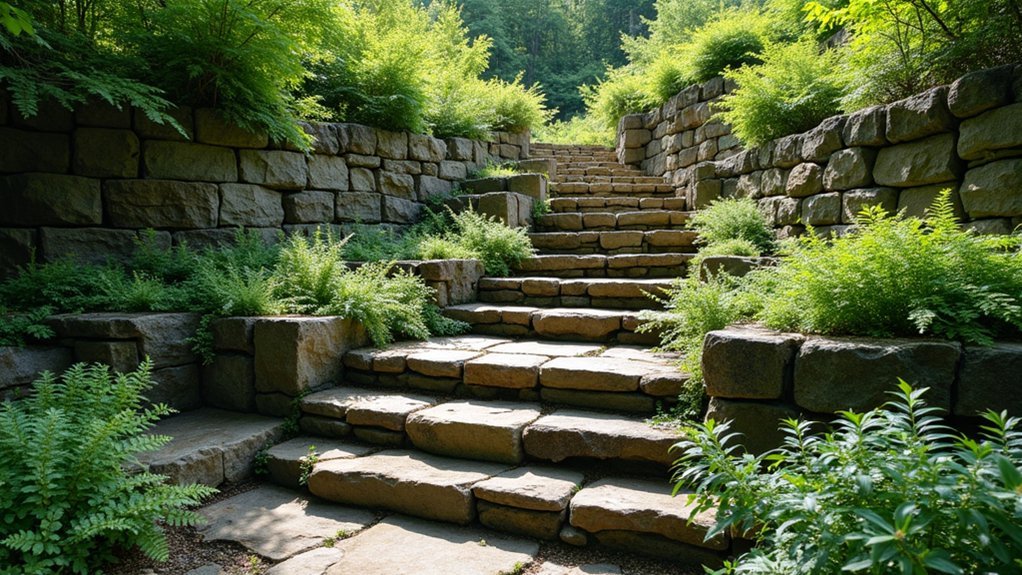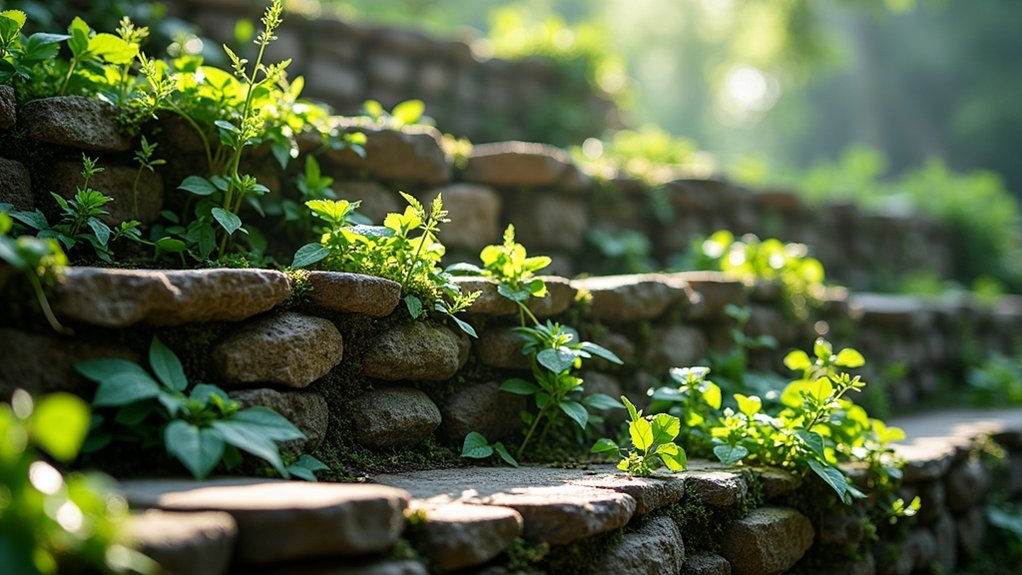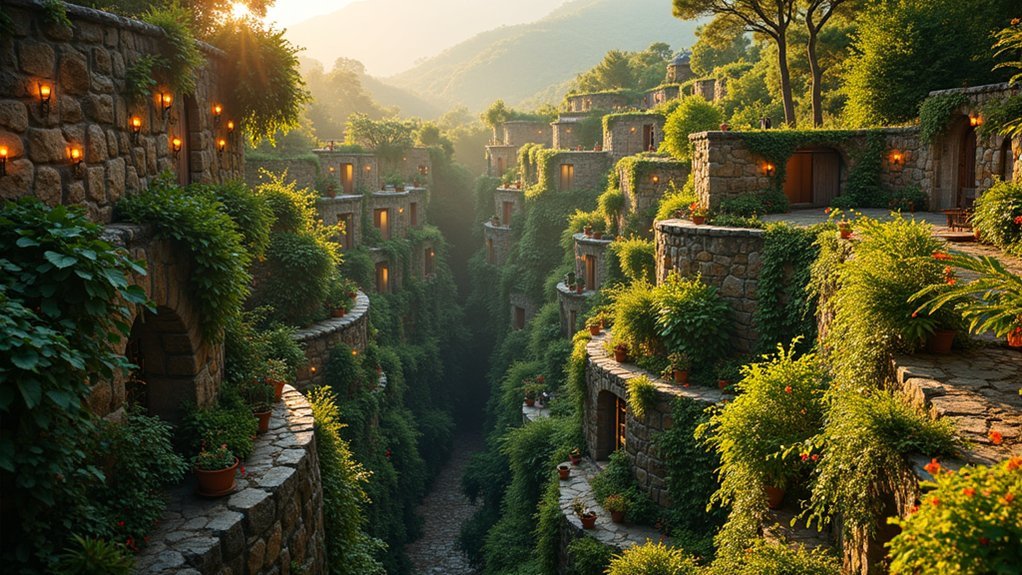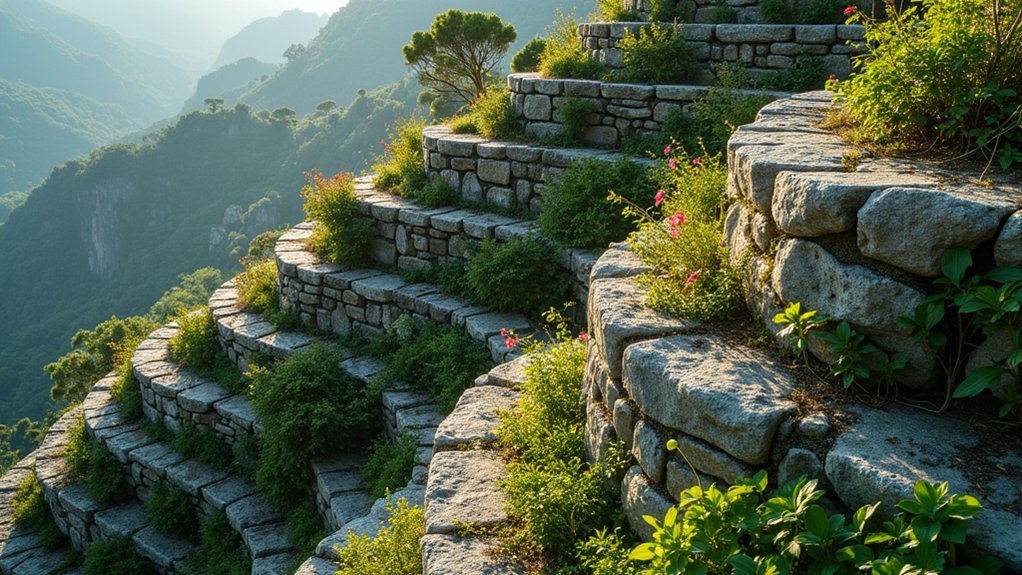Terraced stone walls create stunning multi-level garden spaces where structural hardscape meets lush greenery. You’ll achieve the most breathtaking results by combining drought-tolerant succulents with cascading flowering plants that soften edges while adding vibrant color. Enhance your design with strategic lighting—LED strips or solar fixtures—to showcase plant silhouettes after dark. Proper drainage systems and foundation preparation guarantee longevity, while mixing local stone materials offers both visual interest and cost savings. The perfect terraced garden awaits in these essential details.
The Natural Harmony of Stone and Greenery

While many landscape elements compete for attention, terraced stone walls create a perfect backdrop that allows both hardscape and plants to shine together. The varied textures of stone complement your garden’s greenery, providing structure while plants add life and softness to the rigid lines.
You’ll find this partnership isn’t just visually pleasing—it’s practical too. As cascading plants like creeping thyme spill over your stone wall edges, they blur the boundary between built and natural environments. This combination improves drainage and prevents soil erosion, creating healthier growing conditions.
The stone’s natural variations add depth to your landscape, while seasonal flowers planted throughout the terraces guarantee your garden remains vibrant year-round. This thoughtful integration celebrates the timeless beauty of both elements working in harmony.
Planning Your Terraced Stone Wall Garden
Transforming that natural harmony into reality begins with thoughtful planning. Assess your property’s slope first, as terraced walls excel at managing steep terrain while preventing soil erosion. Your material selection will define both aesthetics and functionality—fieldstone and flagstone offer natural beauty with necessary durability.
Consider these essential planning elements:
- Accessibility – Design pathways that allow easy maintenance and create distinct planting zones.
- Plant selection – Choose varieties suited to your specific climate and each terrace’s microclimate.
- Drainage solutions – Guarantee proper water management throughout your terraced walls.
- Functional additions – Incorporate built-in seating or viewing areas to enhance enjoyment.
With careful planning, your terraced stone garden will balance stunning visual impact with practical land management, creating a sanctuary that’s both beautiful and sustainable.
Selecting the Perfect Stones for Terraced Walls

The foundation of any breathtaking terraced wall lies in its building blocks—the stones themselves. When choosing materials for your stone structure, natural options like fieldstone and flagstone offer both visual appeal and resistance to weathering effects.
Select stones with varying sizes and textures to create visual interest that enhances the wall’s natural aesthetic. Remember that dry-stacked walls shouldn’t exceed four feet in height without mortar for stability.
Position larger boulders at the base to establish a solid foundation and improve drainage, preventing erosion issues that could compromise your wall’s integrity. This thoughtful arrangement also helps manage water flow through the structure.
For a cohesive landscape design, choose stones that complement your surrounding architecture and garden elements. This careful selection guarantees your terraced wall becomes a seamless, stunning addition to your outdoor space.
Structural Considerations for Stable Terraces
Your terraced stone wall’s stability depends first on proper foundation preparation, with a compacted base of crushed gravel extending below the frost line.
You’ll need thoughtful drainage techniques, including backfilling with gravel and installing weep holes, to prevent water pressure from compromising your wall’s structural integrity.
Distribute weight strategically by placing your largest stones at the bottom and staggering joints between layers, creating a naturally reinforced structure that can withstand soil pressure and seasonal changes.
Proper Drainage Techniques
Water management represents the cornerstone of successful terraced stone wall construction, as even the most beautifully crafted structures will fail without proper drainage systems in place.
To protect your investment and guarantee longevity, you’ll need strategic drainage implementation.
Install these essential elements for effective water control:
- Weep holes throughout the wall face to release trapped moisture
- Drainage pipes at the base to direct water away from your terrace foundation
- Gravel backfill behind walls to create a permeable layer that reduces hydrostatic pressure
- Deep-rooted native plants to absorb excess moisture and stabilize soil
Don’t overlook regular maintenance—clear debris from drainage channels and maintain proper grading around your terraces.
Your drainage system’s effectiveness directly impacts the structural integrity and beauty of your stone walls over time.
Foundation Preparation Essentials
Before breaking ground on your terraced stone wall project, careful foundation preparation determines whether your structure will stand strong for decades or crumble within seasons. Start by evaluating your soil’s stability and drainage patterns to prevent future erosion issues.
Dig your foundation at least 12 inches deep and slightly wider than your planned wall. This extra width provides essential support, especially for taller terraces. Thoroughly compact the soil before adding a layer of gravel as your base—this combination greatly improves drainage and prevents settling.
Consider installing a French drain system behind your wall to manage water runoff and reduce pressure on the structure.
Don’t overlook local building codes; they’re designed to guarantee your terraced wall remains both beautiful and safe for years to come.
Weight Distribution Methods
With your foundation solidly prepared, the focus shifts to how weight will be balanced throughout your terraced wall structure. Proper weight distribution methods prevent collapse by accounting for soil, plant, and water loads.
For ideal stability in your terraced stone walls:
- Implement a stepped design – This naturally distributes soil weight evenly across the wall’s surface.
- Position heavier stones at the base – Larger materials at the bottom and lighter ones at the top create a stable gradient.
- Install drainage systems behind walls – These reduce hydrostatic pressure that can compromise structural integrity.
- Use geogrid reinforcement for taller terraces – This mesh material enhances soil retention and load-bearing capacity.
These techniques guarantee your terraced walls will support your lush plantings while maintaining their stunning appearance for years to come.
Plant Selection for Thriving Wall Gardens
You’ll want to incorporate drought-tolerant succulents and sedums for your sunny terraced stone walls, minimizing maintenance while creating stunning visual impact.
For softer edges and romantic appeal, consider cascading flowering varieties like trailing geraniums or ivy that spill gracefully over stonework.
Complete your design with year-round color performers such as lavender and daylilies, ensuring your wall garden remains visually interesting through all seasons.
Drought-Tolerant Succulent Options
When designing your terraced stone wall garden, selecting the right plants can make all the difference between constant maintenance and effortless beauty.
Drought-tolerant succulents are ideal candidates for these spaces, offering stunning visual appeal while requiring minimal care.
These water-wise plants thrive in well-drained soil and can endure extreme temperatures, making them perfect for various climates:
- Agave – Provides dramatic architectural elements with its bold, spiky form
- Sedum – Creates cascading effects with its trailing varieties in multiple colors
- Echeveria – Forms elegant rosettes in blue-green to pink hues
- Sempervivum – Offers tight clusters of textured rosettes that multiply readily
Cascading Flowering Varieties
While succulents provide structural beauty in terraced walls, adding cascading flowering varieties brings a new dimension of color and movement to your stone landscape. These plants soften harsh stone edges while creating visual interest through their flowing habit.
| Plant Variety | Best Features |
|---|---|
| Creeping Phlox | Spring blooms, excellent coverage |
| Trailing Lobelia | Vibrant blues, continuous flowering |
| Saxifraga | Hardy alpine, thrives in rocky conditions |
| Calibrachoa | Abundant blooms, attracts pollinators |
| Alyssum | Fragrant spring flowers, drought-tolerant |
You’ll achieve year-round interest by combining perennials like dianthus with annuals such as petunias. For summer color, consider ornamental sweet potatoes that cascade dramatically down stone faces. These cascading flowering varieties not only enhance your wall’s appearance but also create essential habitat for beneficial pollinators.
Year-Round Color Performers
Designing a stone wall garden that maintains visual interest throughout the seasons requires strategic plant selection. Your terraced wall features deserve plants that perform beautifully in every season, not just during peak growing periods.
To achieve year-round color in your stone wall garden, consider:
- Evergreen foundation plants – Boxwoods and hollies provide consistent structure and color even through winter months.
- Drought-tolerant perennials – Sedums and succulents thrive in rocky environments while adding unique textures.
- Seasonal bloomers – Coneflowers and black-eyed Susans deliver waves of color at different times throughout the year.
- Strategic annuals – Incorporate petunias or marigolds in planting pockets for vibrant seasonal bursts.
Vertical garden systems filled with herbs can transform ordinary wall features into functional, beautiful year-round color performers that enhance your outdoor living space.
Creating Effective Drainage Systems
Although often overlooked, proper drainage forms the backbone of any successful terraced stone wall project. Without it, your beautiful stone structure could eventually fail due to water pressure and soil erosion.
Incorporate weep holes into your wall design to allow water to escape naturally. Behind the wall, install a drainage layer of gravel or crushed stone that facilitates water movement and prevents soil saturation.
For ideal results, place perforated drainage pipes at the base to efficiently redirect water away from your structure.
Don’t forget that maintenance is essential for long-term success. Regularly clear debris from your drainage systems to guarantee they continue functioning properly.
With these measures in place, you’ll enjoy structurally sound terraced walls that showcase your plantings while effectively managing water flow.
Step-by-Step Construction Guide

Begin your terraced stone wall project by selecting durable materials like fieldstone or mortared stone that’ll complement your landscape while ensuring longevity.
You’ll need to thoroughly excavate the area, creating a level foundation that extends at least twice the width of your chosen stones to prevent future shifting and instability.
After establishing this critical base, arrange your first tier of stones in a staggered pattern, which not only creates visual interest but also greatly strengthens the entire structure.
Materials and Site Preparation
Before you pick up a single stone, careful selection of materials and thorough site preparation will determine the success of your terraced stone walls.
Choose fieldstone or granite for their durability and natural aesthetic. They’ll withstand harsh weather while providing essential structural support for your terraced design.
Begin your project by:
- Clearing the site completely of vegetation and debris
- Creating a level foundation area where your stone walls will rest
- Excavating soil in a stepped pattern to establish each terrace tier
- Adding a layer of gravel at the base for proper drainage
Don’t skip measuring accurately throughout the process.
Consistent heights between terraces create visual harmony, while proper alignment guarantees your stone walls will remain stable for years to come.
Building Strong Foundations
Once you’ve completed site preparation, turning your attention to foundation work becomes essential for long-lasting terraced stone walls.
Begin by excavating a trench at least 6 inches deep and 12 inches wide, following the natural contours you identified during your survey.
Ensure your trench is perfectly level, as this foundation will directly impact your wall’s stability. A properly constructed base allows the walls to provide both structural support and visual appeal for years to come.
Fill the trench with a layer of compacted gravel for improved drainage, then start stacking your chosen stones in a staggered pattern. This interlocking arrangement prevents shifting and creates a stronger structure.
Seasonal Maintenance Tips for Longevity
While your terraced stone walls create stunning visual impact throughout the year, they require consistent attention to maintain their structural integrity and beauty across changing seasons.
Regular maintenance guarantees your stone walls will stand the test of time.
- Inspect walls quarterly – Check for shifting or settling caused by seasonal temperature fluctuations that might require reinforcement.
- Apply protective sealant annually – Shield stone surfaces from moisture damage that leads to erosion.
- Maintain proper drainage – Direct water flow away from wall bases, especially during heavy rainfall periods.
- Manage surrounding vegetation – Prune plants regularly and fertilize appropriately to prevent root damage to the stone structure.
Remember that seasonal maintenance isn’t just about preserving appearance—it’s about protecting your investment and guaranteeing your terraced stone walls remain stunning for decades.
Enhancing Biodiversity With Wall Plantings

Beyond maintenance, your terraced stone walls offer an extraordinary opportunity to create thriving ecosystems within your landscape. The natural crevices and pockets between stones provide perfect growing spaces for diverse wall plantings that attract wildlife.
Choose native plants whenever possible—they’re already adapted to your local climate and naturally attract essential pollinators like bees and butterflies. You’ll create layered habitats when you mix herbs, flowers, and shrubs, supporting organisms at various life stages.
Your vertical garden won’t just look beautiful; it’ll serve as nesting sites and food sources for birds and beneficial insects.
These wall plantings also perform practical functions by absorbing excess stormwater, reducing erosion around your terraces. With thoughtful plant selection, you’re not just building a wall—you’re creating a vibrant microhabitat that enhances your property’s ecological balance.
Incorporating Water Features Into Terraced Designs
As your terraced stone walls create dramatic elevation changes in your landscape, they provide ideal opportunities for incorporating water features that transform ordinary gardens into enchanting retreats.
Water features not only add visual interest but serve practical purposes too.
Consider these strategic placements for maximum impact:
- Position cascading fountains at the top tier to create soothing sounds while utilizing gravity for irrigation.
- Install a reflecting pond as a focal point in the middle section to mirror surrounding stonework.
- Integrate permeable materials around water features to manage runoff and prevent erosion.
- Add small waterfalls between tiers to regulate temperature and humidity for nearby plants.
You’ll find that well-designed water features attract wildlife while creating a peaceful atmosphere that enhances your terraced garden’s natural beauty.
Lighting Options to Showcase Your Wall Garden

Once the sun sets on your magnificent terraced stone walls, strategic lighting transforms them from daytime showpieces into dramatic nighttime sculptures. You’ll find various lighting options that highlight both stonework texture and plant features.
Consider installing LED strip lights along wall edges for a warm, continuous glow. Solar-powered fixtures offer eco-friendly illumination without complex wiring. For dramatic effect, position uplights at the wall’s base to cast shadows that emphasize plant silhouettes.
| Lighting Type | Effect | Best For |
|---|---|---|
| LED Strips | Continuous glow | Wall edges |
| Solar Lights | Soft ambiance | Pathways |
| Uplights | Dramatic shadows | Textured stone |
| Adjustable Spots | Focused illumination | Feature plants |
Add a timer to your system for hassle-free operation, ensuring your terraced masterpiece receives nightly attention without your intervention.
Transforming Slopes Into Functional Spaces
While nighttime illumination adds drama to your stone walls, the daylight hours reveal their true practical value on challenging terrain.
Terracing walls convert problematic slopes into valuable outdoor living areas while preventing soil erosion that could damage your landscape’s foundation.
When planning your terraced stone wall project, consider these key benefits:
- Expanded usable space – Each level creates new areas for gardens, seating, or decorative elements
- Improved drainage control – Strategic stone placement directs water flow away from structures
- Microclimate creation – Various stone sizes and arrangements support diverse plant life
- Property value enhancement – You’ll transform unusable land into attractive, functional space
Cost-Effective Solutions for DIY Enthusiasts
Creating stunning terraced stone walls doesn’t require emptying your wallet when you approach the project with strategic planning.
Mix materials by combining concrete blocks with natural stones for visual appeal without the premium cost.
Consider installing gabion walls—wire cages filled with stones—for an affordable option that provides stability while achieving a rustic look without professional help.
You’ll find substantial savings by sourcing local stones or incorporating reclaimed materials, which add distinctive character to your terraced walls.
Keep your walls under four feet tall to simplify construction and eliminate expenses for heavy equipment.
Design with integrated planting pockets to enhance functionality without purchasing separate planters.
These spaces allow vegetation to cascade beautifully across your terraced landscape, creating the lush aesthetic you desire while maintaining your budget.
Frequently Asked Questions
What Is the Best Plant for Stone Wall?
For your stone wall, you’ll find alpine plants like Primula, creeping ground covers like sedum, and succulents work best. They’ll thrive in rocky conditions and poor soil while adding beautiful texture and color.
What to Plant Next to a Stone Wall?
Next to a stone wall, you’ll thrive with alpine plants like Primula and Dianthus. Add cascading greenery such as creeping phlox or sedum. Don’t forget herbs like oregano that love rocky conditions.
How to Disguise a Retaining Wall?
To disguise a retaining wall, you’ll want to plant climbing vines like ivy or clematis, add trellises for vertical growth, layer shrubs in front, incorporate wall-mounted planters, and place boulders at the base for a natural changeover.
How to Soften a Retaining Wall?
To soften a retaining wall, you’ll want to add cascading greenery, plant flowering perennials at its base, use varied stone sizes, install planter boxes, and strategically place boulders with smaller plants for natural integration.
In Summary
Your terraced stone wall garden is more than a landscape feature—it’s a living masterpiece that marries strength with natural beauty. As you’ve learned, thoughtful planning, proper materials, and suitable plant selection create stunning, sustainable results. Whether you’ve tackled this as a DIY project or hired professionals, you’ve transformed challenging terrain into an enchanting outdoor sanctuary that will evolve and delight for years to come.





Leave a Reply